Appendix A to Part 222 [Reserved]
12:3.0.1.1.3.11.3.1.1 : Appendix A
Appendix A to Part 222 [Reserved]
Appendix B to Part 222 - Model Notices of Furnishing Negative Information
12:3.0.1.1.3.11.3.1.2 : Appendix B
Appendix B to Part 222 - Model Notices of Furnishing Negative
Information
a. Although use of the model notices is not required, a
financial institution that is subject to section 623(a)(7) of the
FCRA shall be deemed to be in compliance with the notice
requirement in section 623(a)(7) of the FCRA if the institution
properly uses the model notices in this appendix (as
applicable).
b. A financial institution may use Model Notice B-1 if the
institution provides the notice prior to furnishing negative
information to a nationwide consumer reporting agency.
c. A financial institution may use Model Notice B-2 if the
institution provides the notice after furnishing negative
information to a nationwide consumer reporting agency.
d. Financial institutions may make certain changes to the
language or format of the model notices without losing the safe
harbor from liability provided by the model notices. The changes to
the model notices may not be so extensive as to affect the
substance, clarity, or meaningful sequence of the language in the
model notices. Financial institutions making such extensive
revisions will lose the safe harbor from liability that this
appendix provides. Acceptable changes include, for example,
1. Rearranging the order of the references to “late payment(s),”
or “missed payment(s)”
2. Pluralizing the terms “credit bureau,” “credit report,” and
“account”
3. Specifying the particular type of account on which
information may be furnished, such as “credit card account”
4. Rearranging in Model Notice B-1 the phrases “information
about your account” and “to credit bureaus” such that it would read
“We may report to credit bureaus information about your
account.”
Model Notice B-1
We may report information about your account to credit bureaus.
Late payments, missed payments, or other defaults on your account
may be reflected in your credit report.
Model Notice B-2
We have told a credit bureau about a late payment, missed
payment or other default on your account. This information may be
reflected in your credit report.
[69 FR 33285, June 15, 2004]
Appendix C to Part 222 - Model Forms for Opt-Out Notices
12:3.0.1.1.3.11.3.1.3 : Appendix C
Appendix C to Part 222 - Model Forms for Opt-Out Notices
a. Although use of the model forms is not required, use of the
model forms in this appendix (as applicable) complies with the
requirement in section 624 of the Act for clear, conspicuous, and
concise notices.
b. Certain changes may be made to the language or format of the
model forms without losing the protection from liability afforded
by use of the model forms. These changes may not be so extensive as
to affect the substance, clarity, or meaningful sequence of the
language in the model forms. Persons making such extensive
revisions will lose the safe harbor that this appendix provides.
Acceptable changes include, for example:
1. Rearranging the order of the references to “your income,”
“your account history,” and “your credit score.”
2. Substituting other types of information for “income,”
“account history,” or “credit score” for accuracy, such as “payment
history,” “credit history,” “payoff status,” or “claims
history.”
3. Substituting a clearer and more accurate description of the
affiliates providing or covered by the notice for phrases such as
“the [ABC] group of companies,” including without limitation a
statement that the entity providing the notice recently purchased
the consumer's account.
4. Substituting other types of affiliates covered by the notice
for “credit card,” “insurance,” or “securities” affiliates.
5. Omitting items that are not accurate or applicable. For
example, if a person does not limit the duration of the opt-out
period, the notice may omit information about the renewal
notice.
6. Adding a statement informing consumers how much time they
have to opt out before shared eligibility information may be used
to make solicitations to them.
7. Adding a statement that the consumer may exercise the right
to opt out at any time.
8. Adding the following statement, if accurate: “If you
previously opted out, you do not need to do so again.”
9. Providing a place on the form for the consumer to fill in
identifying information, such as his or her name and address.
10. Adding disclosures regarding the treatment of opt-outs by
joint consumers to comply with § 222.23(a)(2) of this part.
C-1 Model Form for Initial Opt-out Notice (Single-Affiliate Notice)
C-2 Model Form for Initial Opt-out Notice (Joint Notice) C-3 Model
Form for Renewal Notice (Single-Affiliate Notice) C-4 Model Form
for Renewal Notice (Joint Notice) C-5 Model Form for Voluntary “No
Marketing” Notice C-6 Model Form for Voluntary “No Marketing”
Notice C-1 - Model Form for Initial Opt-out Notice
(Single-Affiliate Notice) - [Your Choice To Limit
Marketing]/[Marketing Opt-out]
• [Name of Affiliate] is providing this notice.
• [Optional: Federal law gives you the right to limit some but
not all marketing from our affiliates. Federal law also requires us
to give you this notice to tell you about your choice to limit
marketing from our affiliates.]
• You may limit our affiliates in the [ABC] group of companies,
such as our [credit card, insurance, and securities] affiliates,
from marketing their products or services to you based on your
personal information that we collect and share with them. This
information includes your [income], your [account history with us],
and your [credit score].
• Your choice to limit marketing offers from our affiliates will
apply [until you tell us to change your choice]/[for x years from
when you tell us your choice]/[for at least 5 years from when you
tell us your choice]. [Include if the opt-out period expires.] Once
that period expires, you will receive a renewal notice that will
allow you to continue to limit marketing offers from our affiliates
for [another x years]/[at least another 5 years].
• [Include, if applicable, in a subsequent notice, including an
annual notice, for consumers who may have previously opted out.] If
you have already made a choice to limit marketing offers from our
affiliates, you do not need to act again until you receive the
renewal notice.
To limit marketing offers, contact us [include all that
apply]:
• By telephone: 1-877-###-####
• On the Web: www. - .com
• By mail: Check the box and complete the form below, and send
the form to:
[Company name] [Company address]
_Do not allow your affiliates to use my personal information to
market to me.
C-2 - Model Form for Initial Opt-out Notice (Joint Notice) - [Your
Choice To Limit Marketing]/[Marketing Opt-out]
• The [ABC group of companies] is providing this notice.
• [Optional: Federal law gives you the right to limit some but
not all marketing from the [ABC] companies. Federal law also
requires us to give you this notice to tell you about your choice
to limit marketing from the [ABC] companies.]
• You may limit the [ABC] companies, such as the [ABC credit
card, insurance, and securities] affiliates, from marketing their
products or services to you based on your personal information that
they receive from other [ABC] companies. This information includes
your [income], your [account history], and your [credit score].
• Your choice to limit marketing offers from the [ABC] companies
will apply [until you tell us to change your choice]/[for x years
from when you tell us your choice]/[for at least 5 years from when
you tell us your choice]. [Include if the opt-out period expires.]
Once that period expires, you will receive a renewal notice that
will allow you to continue to limit marketing offers from the [ABC]
companies for [another x years]/[at least another 5 years].
• [Include, if applicable, in a subsequent notice, including an
annual notice, for consumers who may have previously opted out.] If
you have already made a choice to limit marketing offers from the
[ABC] companies, you do not need to act again until you receive the
renewal notice.
To limit marketing offers, contact us [include all that
apply]:
• By telephone: 1-877-###-####
• On the Web: www. - .com
• By mail: Check the box and complete the form below, and send
the form to:
[Company name] [Company address]
_Do not allow any company [in the ABC group of companies] to use
my personal information to market to me.
C-3 - Model Form for Renewal Notice (Single-Affiliate Notice) -
[Renewing Your Choice To Limit Marketing]/[Renewing Your Marketing
Opt-Out]
• [Name of Affiliate] is providing this notice.
• [Optional: Federal law gives you the right to limit some but
not all marketing from our affiliates. Federal law also requires us
to give you this notice to tell you about your choice to limit
marketing from our affiliates.]
• You previously chose to limit our affiliates in the [ABC]
group of companies, such as our [credit card, insurance, and
securities] affiliates, from marketing their products or services
to you based on your personal information that we share with them.
This information includes your [income], your [account history with
us], and your [credit score].
• Your choice has expired or is about to expire.
To renew your choice to limit marketing for [x] more years,
contact us [include all that apply]:
• By telephone: 1-877-###-####
• On the Web: www. - .com
• By mail: Check the box and complete the form below, and send
the form to:
[Company name] [Company address] _Renew my choice to limit
marketing for [x] more years. C-4 - Model Form for Renewal Notice
(Joint Notice) - [Renewing Your Choice To Limit
Marketing]/[Renewing Your Marketing Opt-Out]
• The [ABC group of companies] is providing this notice.
• [Optional: Federal law gives you the right to limit some but
not all marketing from the [ABC] companies. Federal law also
requires us to give you this notice to tell you about your choice
to limit marketing from the [ABC] companies.]
• You previously chose to limit the [ABC] companies, such as the
[ABC credit card, insurance, and securities] affiliates, from
marketing their products or services to you based on your personal
information that they receive from other ABC companies. This
information includes your [income], your [account history], and
your [credit score].
• Your choice has expired or is about to expire.
To renew your choice to limit marketing for [x] more years,
contact us [include all that apply]:
• By telephone: 1-877-###-####
• On the Web: www. - .com
• By mail: Check the box and complete the form below, and send
the form to:
[Company name] [Company address] _Renew my choice to limit
marketing for [x] more years. C-5 - Model Form for Voluntary “No
Marketing” Notice Your Choice To Stop Marketing
• [Name of Affiliate] is providing this notice.
• You may choose to stop all marketing from us and our
affiliates.
• [Your choice to stop marketing from us and our affiliates will
apply until you tell us to change your choice.]
To stop all marketing, contact us [include all that apply]:
• By telephone: 1-877-###-####
• On the Web: www. - .com
• By mail: Chec>k the box and complete the form below, and
send the form to:
[Company name] [Company address] _Do not market to me. [Reg. V, 72
FR 62962, Nov. 7, 2007, as amended at 74 FR 22642, May 14, 2009]
Appendix D to Part 222 [Reserved]
12:3.0.1.1.3.11.3.1.4 : Appendix D
Appendix D to Part 222 [Reserved]
Appendix E to Part 222 - Interagency Guidelines Concerning the Accuracy and Integrity of Information Furnished to Consumer Reporting Agencies
12:3.0.1.1.3.11.3.1.5 : Appendix E
Appendix E to Part 222 - Interagency Guidelines Concerning the
Accuracy and Integrity of Information Furnished to Consumer
Reporting Agencies
The Board encourages voluntary furnishing of information to
consumer reporting agencies. Section 222.42 of this part requires
each furnisher to establish and implement reasonable written
policies and procedures concerning the accuracy and integrity of
the information it furnishes to consumer reporting agencies. Under
§ 222.42(b) of this part, a furnisher must consider the guidelines
set forth below in developing its policies and procedures. In
establishing these policies and procedures, a furnisher may include
any of its existing policies and procedures that are relevant and
appropriate. Section 222.42(c) requires each furnisher to review
its policies and procedures periodically and update them as
necessary to ensure their continued effectiveness.
I. Nature, Scope, and Objectives of Policies and Procedures
(a) Nature and Scope. Section 222.42(a) of this part
requires that a furnisher's policies and procedures be appropriate
to the nature, size, complexity, and scope of the furnisher's
activities. In developing its policies and procedures, a furnisher
should consider, for example:
(1) The types of business activities in which the furnisher
engages;
(2) The nature and frequency of the information the furnisher
provides to consumer reporting agencies; and
(3) The technology used by the furnisher to furnish information
to consumer reporting agencies.
(b) Objectives. A furnisher's policies and procedures
should be reasonably designed to promote the following
objectives:
(1) To furnish information about accounts or other relationships
with a consumer that is accurate, such that the furnished
information:
(i) Identifies the appropriate consumer;
(ii) Reflects the terms of and liability for those accounts or
other relationships; and
(iii) Reflects the consumer's performance and other conduct with
respect to the account or other relationship;
(2) To furnish information about accounts or other relationships
with a consumer that has integrity, such that the furnished
information:
(i) Is substantiated by the furnisher's records at the time it
is furnished;
(ii) Is furnished in a form and manner that is designed to
minimize the likelihood that the information may be incorrectly
reflected in a consumer report; thus, the furnished information
should:
(A) Include appropriate identifying information about the
consumer to whom it pertains; and
(B) Be furnished in a standardized and clearly understandable
form and manner and with a date specifying the time period to which
the information pertains; and
(iii) Includes the credit limit, if applicable and in the
furnisher's possession;
(3) To conduct reasonable investigations of consumer disputes
and take appropriate actions based on the outcome of such
investigations; and
(4) To update the information it furnishes as necessary to
reflect the current status of the consumer's account or other
relationship, including, for example:
(i) Any transfer of an account (e.g., by sale or
assignment for collection) to a third party; and
(ii) Any cure of the consumer's failure to abide by the terms of
the account or other relationship.
II. Establishing and Implementing Policies and Procedures
In establishing and implementing its policies and procedures, a
furnisher should:
(a) Identify practices or activities of the furnisher that can
compromise the accuracy or integrity of information furnished to
consumer reporting agencies, such as by:
(1) Reviewing its existing practices and activities, including
the technological means and other methods it uses to furnish
information to consumer reporting agencies and the frequency and
timing of its furnishing of information;
(2) Reviewing its historical records relating to accuracy or
integrity or to disputes; reviewing other information relating to
the accuracy or integrity of information provided by the furnisher
to consumer reporting agencies; and considering the types of
errors, omissions, or other problems that may have affected the
accuracy or integrity of information it has furnished about
consumers to consumer reporting agencies;
(3) Considering any feedback received from consumer reporting
agencies, consumers, or other appropriate parties;
(4) Obtaining feedback from the furnisher's staff; and
(5) Considering the potential impact of the furnisher's policies
and procedures on consumers.
(b) Evaluate the effectiveness of existing policies and
procedures of the furnisher regarding the accuracy and integrity of
information furnished to consumer reporting agencies; consider
whether new, additional, or different policies and procedures are
necessary; and consider whether implementation of existing policies
and procedures should be modified to enhance the accuracy and
integrity of information about consumers furnished to consumer
reporting agencies.
(c) Evaluate the effectiveness of specific methods (including
technological means) the furnisher uses to provide information to
consumer reporting agencies; how those methods may affect the
accuracy and integrity of the information it provides to consumer
reporting agencies; and whether new, additional, or different
methods (including technological means) should be used to provide
information to consumer reporting agencies to enhance the accuracy
and integrity of that information.
III. Specific Components of Policies and Procedures
In developing its policies and procedures, a furnisher should
address the following, as appropriate:
(a) Establishing and implementing a system for furnishing
information about consumers to consumer reporting agencies that is
appropriate to the nature, size, complexity, and scope of the
furnisher's business operations.
(b) Using standard data reporting formats and standard
procedures for compiling and furnishing data, where feasible, such
as the electronic transmission of information about consumers to
consumer reporting agencies.
(c) Maintaining records for a reasonable period of time, not
less than any applicable recordkeeping requirement, in order to
substantiate the accuracy of any information about consumers it
furnishes that is subject to a direct dispute.
(d) Establishing and implementing appropriate internal controls
regarding the accuracy and integrity of information about consumers
furnished to consumer reporting agencies, such as by implementing
standard procedures and verifying random samples of information
provided to consumer reporting agencies.
(e) Training staff that participates in activities related to
the furnishing of information about consumers to consumer reporting
agencies to implement the policies and procedures.
(f) Providing for appropriate and effective oversight of
relevant service providers whose activities may affect the accuracy
or integrity of information about consumers furnished to consumer
reporting agencies to ensure compliance with the policies and
procedures.
(g) Furnishing information about consumers to consumer reporting
agencies following mergers, portfolio acquisitions or sales, or
other acquisitions or transfers of accounts or other obligations in
a manner that prevents re-aging of information, duplicative
reporting, or other problems that may similarly affect the accuracy
or integrity of the information furnished.
(h) Deleting, updating, and correcting information in the
furnisher's records, as appropriate, to avoid furnishing inaccurate
information.
(i) Conducting reasonable investigations of disputes.
(j) Designing technological and other means of communication
with consumer reporting agencies to prevent duplicative reporting
of accounts, erroneous association of information with the wrong
consumer(s), and other occurrences that may compromise the accuracy
or integrity of information provided to consumer reporting
agencies.
(k) Providing consumer reporting agencies with sufficient
identifying information in the furnisher's possession about each
consumer about whom information is furnished to enable the consumer
reporting agency properly to identify the consumer.
(l) Conducting a periodic evaluation of its own practices,
consumer reporting agency practices of which the furnisher is
aware, investigations of disputed information, corrections of
inaccurate information, means of communication, and other factors
that may affect the accuracy or integrity of information furnished
to consumer reporting agencies.
(m) Complying with applicable requirements under the Fair Credit
Reporting Act and its implementing regulations.
[Reg. V, 74 FR 31516, July 1, 2009]
Appendixes F-G to Part 222 [Reserved]
12:3.0.1.1.3.11.3.1.6 :
Appendixes F-G to Part 222 [Reserved]
Appendix H to Part 222 - Model Forms for Risk-Based Pricing and Credit Score Disclosure Exception Notices
12:3.0.1.1.3.11.3.1.7 : Appendix H
Appendix H to Part 222 - Model Forms for Risk-Based Pricing and
Credit Score Disclosure Exception Notices
1. This appendix contains four model forms for risk-based
pricing notices and three model forms for use in connection with
the credit score disclosure exceptions. Each of the model forms is
designated for use in a particular set of circumstances as
indicated by the title of that model form.
2. Model form H-1 is for use in complying with the general
risk-based pricing notice requirements in Sec. 222.72 if a credit
score is not used in setting the material terms of credit. Model
form H-2 is for risk-based pricing notices given in connection with
account review if a credit score is not used in increasing the
annual percentage rate. Model form H-3 is for use in connection
with the credit score disclosure exception for loans secured by
residential real property. Model form H-4 is for use in connection
with the credit score disclosure exception for loans that are not
secured by residential real property. Model form H-5 is for use in
connection with the credit score disclosure exception when no
credit score is available for a consumer. Model form H-6 is for use
in complying with the general risk-based pricing notice
requirements in Sec. 222.72 if a credit score is used in setting
the material terms of credit. Model form H-7 is for risk-based
pricing notices given in connection with account review if a credit
score is used in increasing the annual percentage rate. All forms
contained in this appendix are models; their use is optional.
3. A person may change the forms by rearranging the format or by
making technical modifications to the language of the forms, in
each case without modifying the substance of the disclosures. Any
such rearrangement or modification of the language of the model
forms may not be so extensive as to materially affect the
substance, clarity, comprehensibility, or meaningful sequence of
the forms. Persons making revisions with that effect will lose the
benefit of the safe harbor for appropriate use of Appendix H model
forms. A person is not required to conduct consumer testing when
rearranging the format of the model forms.
a. Acceptable changes include, for example
i. Corrections or updates to telephone numbers, mailing
addresses, or Web site addresses that may change over time.
ii. The addition of graphics or icons, such as the person's
corporate logo.
iii. Alteration of the shading or color contained in the model
forms.
iv. Use of a different form of graphical presentation to depict
the distribution of credit scores.
v. Substitution of the words “credit” and “creditor” or
“finance” and “finance company” for the terms “loan” and
“lender.”
vi. Including pre-printed lists of the sources of consumer
reports or consumer reporting agencies in a “check-the-box”
format.
vii. Including the name of the consumer, transaction
identification numbers, a date, and other information that will
assist in identifying the transaction to which the form
pertains.
viii. Including the name of an agent, such as an auto dealer or
other party, when providing the “Name of the Entity Providing the
Notice.”
b. Unacceptable changes include, for example
i. Providing model forms on register receipts or interspersed
with other disclosures.
ii. Eliminating empty lines and extra spaces between sentences
within the same section.
4. Optional language in model forms H-6 and H-7 may be used to
direct the consumer to the entity (which may be a consumer
reporting agency or the creditor itself, for a proprietary score
that meets the definition of a credit score) that provided the
credit score for any questions about the credit score, along with
the entity's contact information. Creditors may use or not use the
additional language without losing the safe harbor, since the
language is optional.
H-1 Model form for risk-based pricing notice.
H-2 Model form for account review risk-based pricing notice.
H-3 Model form for credit score disclosure exception for credit
secured by one to four units of residential real property.
H-4 Model form for credit score disclosure exception for loans
not secured by residential real property.
H-5 Model form for credit score disclosure exception for loans
where credit score is not available.
H-6 Model form for risk-based pricing notice with credit score
information
H-7 Model form for account review risk-based pricing notice with
credit score information
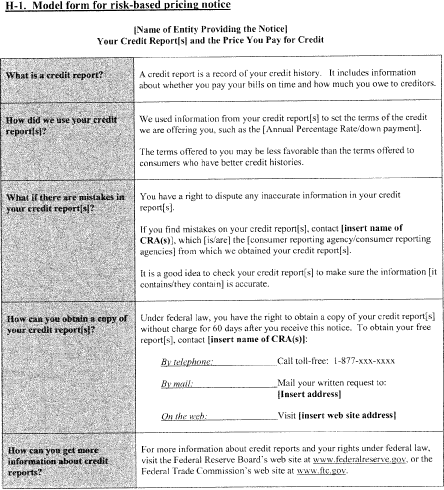

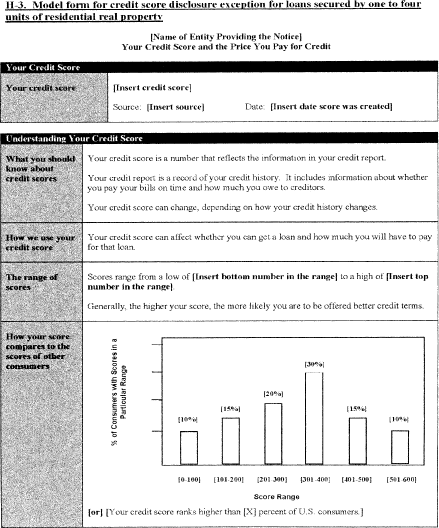


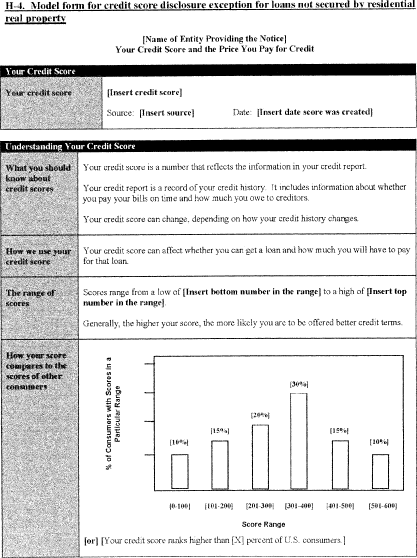
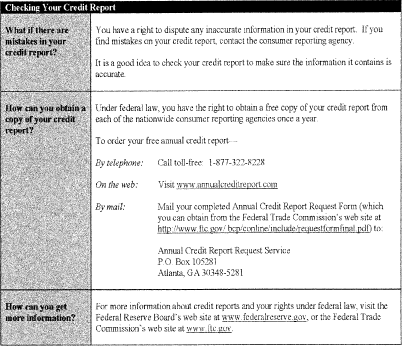

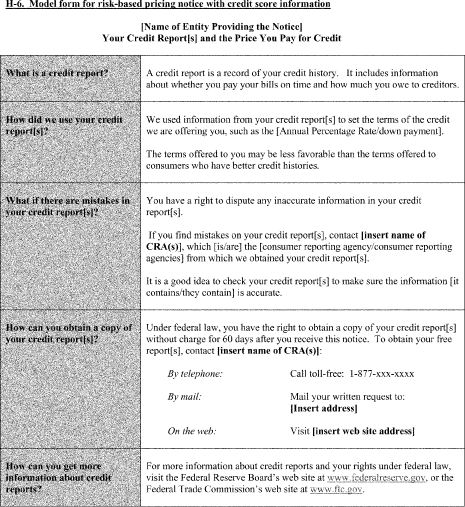
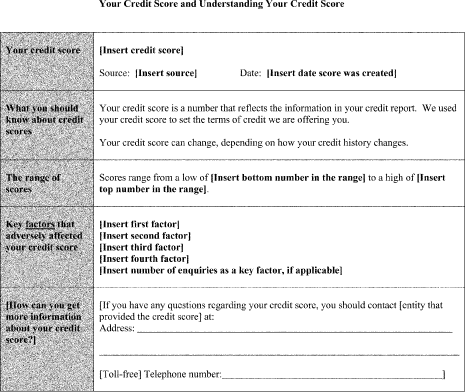
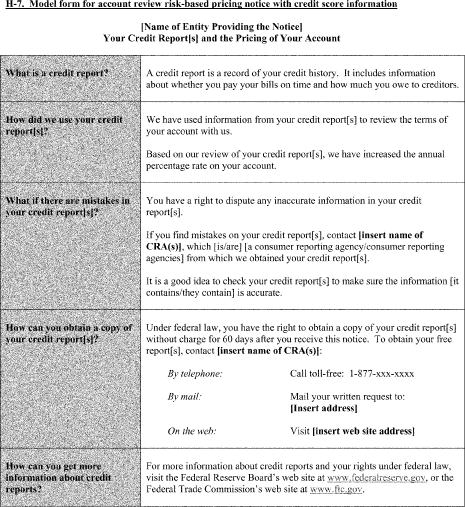

[75 FR 2759, Jan.
15, 2010, as amended at 76 FR 41617, July 15, 2011]
Appendix I to Part 222 [Reserved]
12:3.0.1.1.3.11.3.1.8 : Appendix I
Appendix I to Part 222 [Reserved]
Appendix J to Part 222 - Interagency Guidelines on Identity Theft Detection, Prevention, and Mitigation
12:3.0.1.1.3.11.3.1.9 : Appendix J
Appendix J to Part 222 - Interagency Guidelines on Identity Theft
Detection, Prevention, and Mitigation
Section 222.90 of this part requires each financial institution
and creditor that offers or maintains one or more covered accounts,
as defined in § 222.90(b)(3) of this part, to develop and provide
for the continued administration of a written Program to detect,
prevent, and mitigate identity theft in connection with the opening
of a covered account or any existing covered account. These
guidelines are intended to assist financial institutions and
creditors in the formulation and maintenance of a Program that
satisfies the requirements of § 222.90 of this part.
I. The Program
In designing its Program, a financial institution or creditor
may incorporate, as appropriate, its existing policies, procedures,
and other arrangements that control reasonably foreseeable risks to
customers or to the safety and soundness of the financial
institution or creditor from identity theft.
II. Identifying Relevant Red Flags
(a) Risk Factors. A financial institution or creditor
should consider the following factors in identifying relevant Red
Flags for covered accounts, as appropriate:
(1) The types of covered accounts it offers or maintains;
(2) The methods it provides to open its covered accounts;
(3) The methods it provides to access its covered accounts;
and
(4) Its previous experiences with identity theft.
(b) Sources of Red Flags. Financial institutions and
creditors should incorporate relevant Red Flags from sources such
as:
(1) Incidents of identity theft that the financial institution
or creditor has experienced;
(2) Methods of identity theft that the financial institution or
creditor has identified that reflect changes in identity theft
risks; and
(3) Applicable supervisory guidance.
(c) Categories of Red Flags. The Program should include
relevant Red Flags from the following categories, as appropriate.
Examples of Red Flags from each of these categories are appended as
Supplement A to this appendix J.
(1) Alerts, notifications, or other warnings received from
consumer reporting agencies or service providers, such as fraud
detection services;
(2) The presentation of suspicious documents;
(3) The presentation of suspicious personal identifying
information, such as a suspicious address change;
(4) The unusual use of, or other suspicious activity related to,
a covered account; and
(5) Notice from customers, victims of identity theft, law
enforcement authorities, or other persons regarding possible
identity theft in connection with covered accounts held by the
financial institution or creditor.
III. Detecting Red Flags
The Program's policies and procedures should address the
detection of Red Flags in connection with the opening of covered
accounts and existing covered accounts, such as by:
(a) Obtaining identifying information about, and verifying the
identity of, a person opening a covered account, for example, using
the policies and procedures regarding identification and
verification set forth in the Customer Identification Program rules
implementing 31 U.S.C. 5318(l) (31 CFR 103.121); and
(b) Authenticating customers, monitoring transactions, and
verifying the validity of change of address requests, in the case
of existing covered accounts.
IV. Preventing and Mitigating Identity Theft
The Program's policies and procedures should provide for
appropriate responses to the Red Flags the financial institution or
creditor has detected that are commensurate with the degree of risk
posed. In determining an appropriate response, a financial
institution or creditor should consider aggravating factors that
may heighten the risk of identity theft, such as a data security
incident that results in unauthorized access to a customer's
account records held by the financial institution, creditor, or
third party, or notice that a customer has provided information
related to a covered account held by the financial institution or
creditor to someone fraudulently claiming to represent the
financial institution or creditor or to a fraudulent website.
Appropriate responses may include the following:
(a) Monitoring a covered account for evidence of identity
theft;
(b) Contacting the customer;
(c) Changing any passwords, security codes, or other security
devices that permit access to a covered account;
(d) Reopening a covered account with a new account number;
(e) Not opening a new covered account;
(f) Closing an existing covered account;
(g) Not attempting to collect on a covered account or not
selling a covered account to a debt collector;
(h) Notifying law enforcement; or
(i) Determining that no response is warranted under the
particular circumstances.
V. Updating the Program
Financial institutions and creditors should update the Program
(including the Red Flags determined to be relevant) periodically,
to reflect changes in risks to customers or to the safety and
soundness of the financial institution or creditor from identity
theft, based on factors such as:
(a) The experiences of the financial institution or creditor
with identity theft;
(b) Changes in methods of identity theft;
(c) Changes in methods to detect, prevent, and mitigate identity
theft;
(d) Changes in the types of accounts that the financial
institution or creditor offers or maintains; and
(e) Changes in the business arrangements of the financial
institution or creditor, including mergers, acquisitions,
alliances, joint ventures, and service provider arrangements.
VI. Methods for Administering the Program
(a) Oversight of Program. Oversight by the board of
directors, an appropriate committee of the board, or a designated
employee at the level of senior management should include:
(1) Assigning specific responsibility for the Program's
implementation;
(2) Reviewing reports prepared by staff regarding compliance by
the financial institution or creditor with § 222.90 of this part;
and
(3) Approving material changes to the Program as necessary to
address changing identity theft risks.
(b) Reports. (1) In general. Staff of the
financial institution or creditor responsible for development,
implementation, and administration of its Program should report to
the board of directors, an appropriate committee of the board, or a
designated employee at the level of senior management, at least
annually, on compliance by the financial institution or creditor
with § 222.90 of this part.
(2) Contents of report. The report should address
material matters related to the Program and evaluate issues such
as: the effectiveness of the policies and procedures of the
financial institution or creditor in addressing the risk of
identity theft in connection with the opening of covered accounts
and with respect to existing covered accounts; service provider
arrangements; significant incidents involving identity theft and
management's response; and recommendations for material changes to
the Program.
(c) Oversight of service provider arrangements. Whenever
a financial institution or creditor engages a service provider to
perform an activity in connection with one or more covered accounts
the financial institution or creditor should take steps to ensure
that the activity of the service provider is conducted in
accordance with reasonable policies and procedures designed to
detect, prevent, and mitigate the risk of identity theft. For
example, a financial institution or creditor could require the
service provider by contract to have policies and procedures to
detect relevant Red Flags that may arise in the performance of the
service provider's activities, and either report the Red Flags to
the financial institution or creditor, or to take appropriate steps
to prevent or mitigate identity theft.
VII. Other Applicable Legal Requirements
Financial institutions and creditors should be mindful of other
related legal requirements that may be applicable, such as:
(a) For financial institutions and creditors that are subject to
31 U.S.C. 5318(g), filing a Suspicious Activity Report in
accordance with applicable law and regulation;
(b) Implementing any requirements under 15 U.S.C. 1681c-1(h)
regarding the circumstances under which credit may be extended when
the financial institution or creditor detects a fraud or active
duty alert;
(c) Implementing any requirements for furnishers of information
to consumer reporting agencies under 15 U.S.C. 1681s-2, for
example, to correct or update inaccurate or incomplete information,
and to not report information that the furnisher has reasonable
cause to believe is inaccurate; and
(d) Complying with the prohibitions in 15 U.S.C. 1681m on the
sale, transfer, and placement for collection of certain debts
resulting from identity theft.
Supplement A to Appendix J
In addition to incorporating Red Flags from the sources
recommended in section II.b. of the Guidelines in appendix J of
this part, each financial institution or creditor may consider
incorporating into its Program, whether singly or in combination,
Red Flags from the following illustrative examples in connection
with covered accounts:
Alerts, Notifications or Warnings from a Consumer Reporting Agency
1. A fraud or active duty alert is included with a consumer
report.
2. A consumer reporting agency provides a notice of credit
freeze in response to a request for a consumer report.
3. A consumer reporting agency provides a notice of address
discrepancy, as defined in 12 CFR 1022.82(b).
4. A consumer report indicates a pattern of activity that is
inconsistent with the history and usual pattern of activity of an
applicant or customer, such as:
a. A recent and significant increase in the volume of
inquiries;
b. An unusual number of recently established credit
relationships;
c. A material change in the use of credit, especially with
respect to recently established credit relationships; or
d. An account that was closed for cause or identified for abuse
of account privileges by a financial institution or creditor.
Suspicious Documents
5. Documents provided for identification appear to have been
altered or forged.
6. The photograph or physical description on the identification
is not consistent with the appearance of the applicant or customer
presenting the identification.
7. Other information on the identification is not consistent
with information provided by the person opening a new covered
account or customer presenting the identification.
8. Other information on the identification is not consistent
with readily accessible information that is on file with the
financial institution or creditor, such as a signature card or a
recent check.
9. An application appears to have been altered or forged, or
gives the appearance of having been destroyed and reassembled.
Suspicious Personal Identifying Information
10. Personal identifying information provided is inconsistent
when compared against external information sources used by the
financial institution or creditor. For example:
a. The address does not match any address in the consumer
report; or
b. The Social Security Number (SSN) has not been issued, or is
listed on the Social Security Administration's Death Master
File.
11. Personal identifying information provided by the customer is
not consistent with other personal identifying information provided
by the customer. For example, there is a lack of correlation
between the SSN range and date of birth.
12. Personal identifying information provided is associated with
known fraudulent activity as indicated by internal or third-party
sources used by the financial institution or creditor. For
example:
a. The address on an application is the same as the address
provided on a fraudulent application; or
b. The phone number on an application is the same as the number
provided on a fraudulent application.
13. Personal identifying information provided is of a type
commonly associated with fraudulent activity as indicated by
internal or third-party sources used by the financial institution
or creditor. For example:
a. The address on an application is fictitious, a mail drop, or
a prison; or
b. The phone number is invalid, or is associated with a pager or
answering service.
14. The SSN provided is the same as that submitted by other
persons opening an account or other customers.
15. The address or telephone number provided is the same as or
similar to the address or telephone number submitted by an
unusually large number of other persons opening accounts or by
other customers.
16. The person opening the covered account or the customer fails
to provide all required personal identifying information on an
application or in response to notification that the application is
incomplete.
17. Personal identifying information provided is not consistent
with personal identifying information that is on file with the
financial institution or creditor.
18. For financial institutions and creditors that use challenge
questions, the person opening the covered account or the customer
cannot provide authenticating information beyond that which
generally would be available from a wallet or consumer report.
Unusual Use of, or Suspicious Activity Related to, the Covered
Account
19. Shortly following the notice of a change of address for a
covered account, the institution or creditor receives a request for
a new, additional, or replacement card or a cell phone, or for the
addition of authorized users on the account.
20. A new revolving credit account is used in a manner commonly
associated with known patterns of fraud. For example:
a. The majority of available credit is used for cash advances or
merchandise that is easily convertible to cash (e.g., electronics
equipment or jewelry); or
b. The customer fails to make the first payment or makes an
initial payment but no subsequent payments.
21. A covered account is used in a manner that is not consistent
with established patterns of activity on the account. There is, for
example:
a. Nonpayment when there is no history of late or missed
payments;
b. A material increase in the use of available credit;
c. A material change in purchasing or spending patterns;
d. A material change in electronic fund transfer patterns in
connection with a deposit account; or
e. A material change in telephone call patterns in connection
with a cellular phone account.
22. A covered account that has been inactive for a reasonably
lengthy period of time is used (taking into consideration the type
of account, the expected pattern of usage and other relevant
factors).
23. Mail sent to the customer is returned repeatedly as
undeliverable although transactions continue to be conducted in
connection with the customer's covered account.
24. The financial institution or creditor is notified that the
customer is not receiving paper account statements.
25. The financial institution or creditor is notified of
unauthorized charges or transactions in connection with a
customer's covered account.
Notice from Customers, Victims of Identity Theft, Law Enforcement
Authorities, or Other Persons Regarding Possible Identity Theft in
Connection with Covered Accounts Held by the Financial Institution
or Creditor
26. The financial institution or creditor is notified by a
customer, a victim of identity theft, a law enforcement authority,
or any other person that it has opened a fraudulent account for a
person engaged in identity theft.
[Reg. V, 72 FR 63758, Nov. 9, 2007, as amended at 74 FR 22642, May
14, 2009; 79 FR 30711, May 29, 2014]